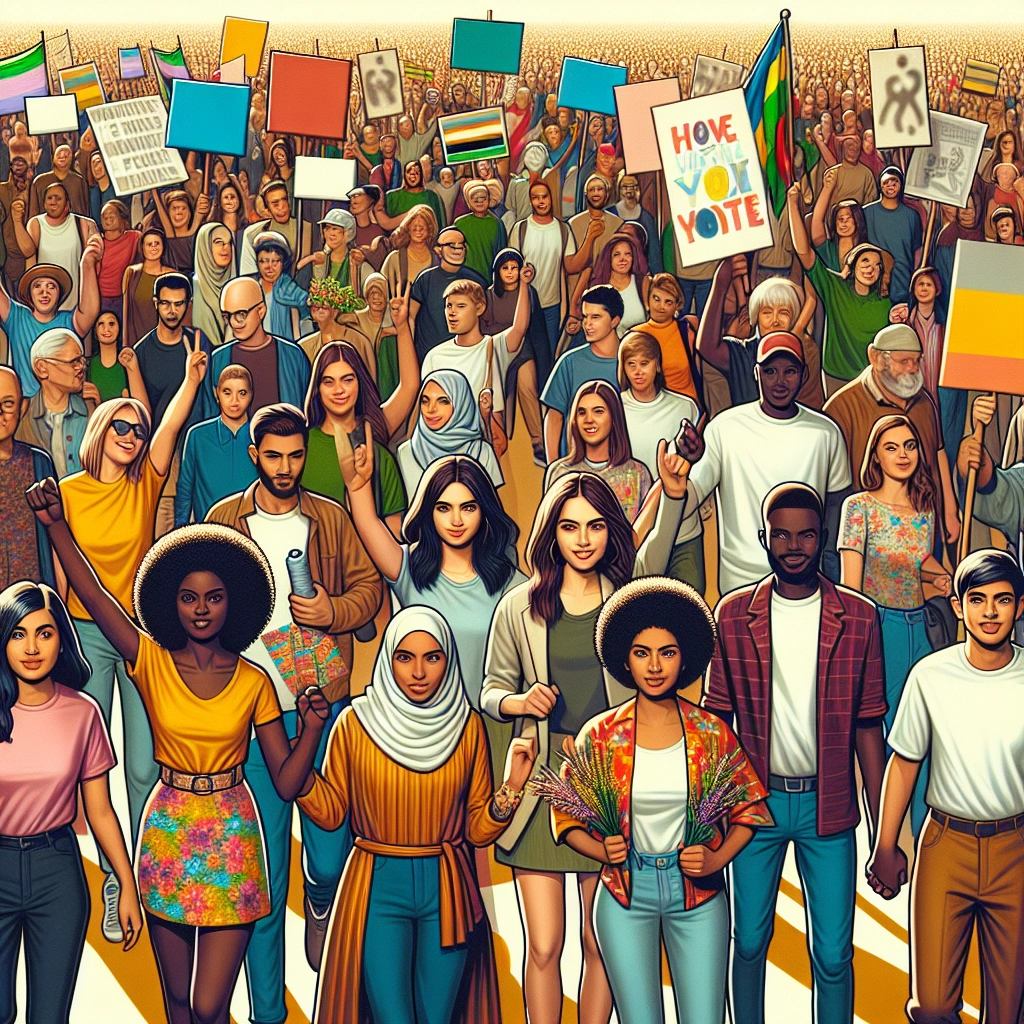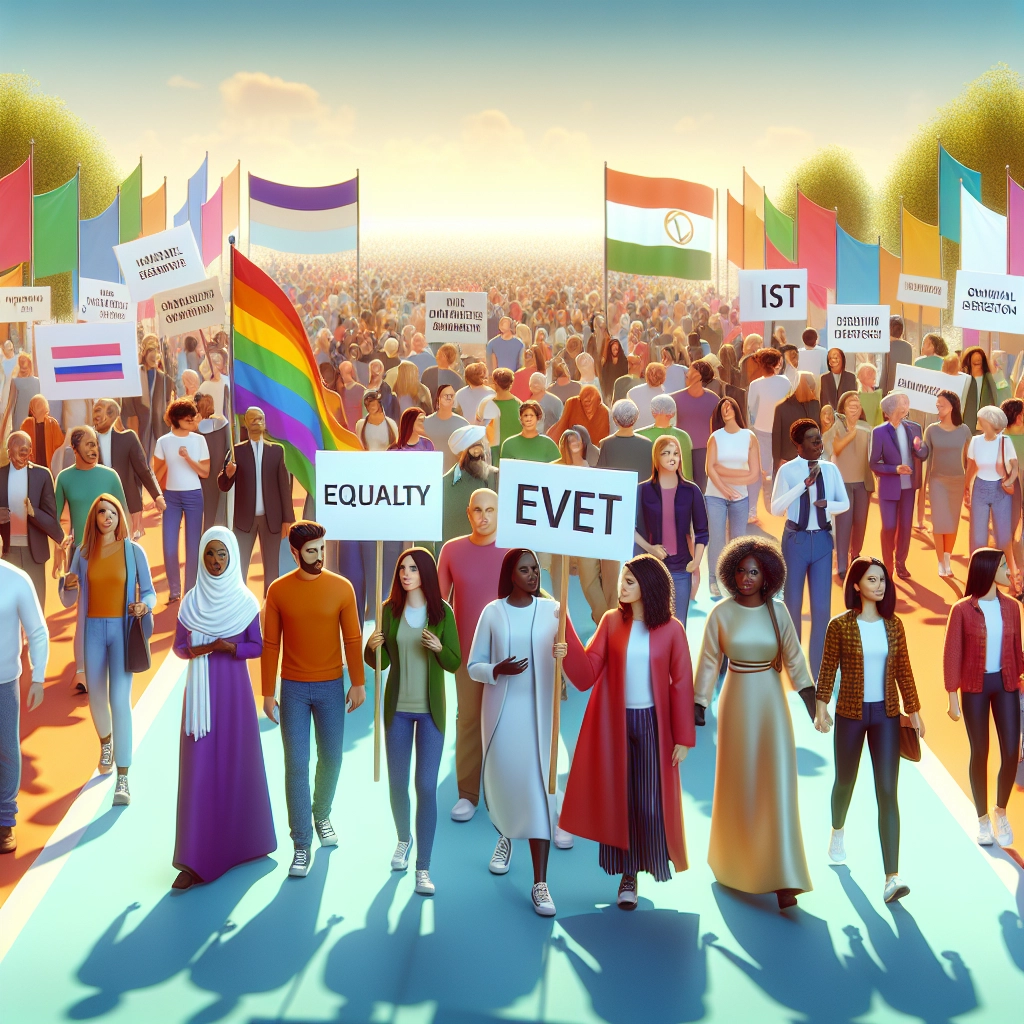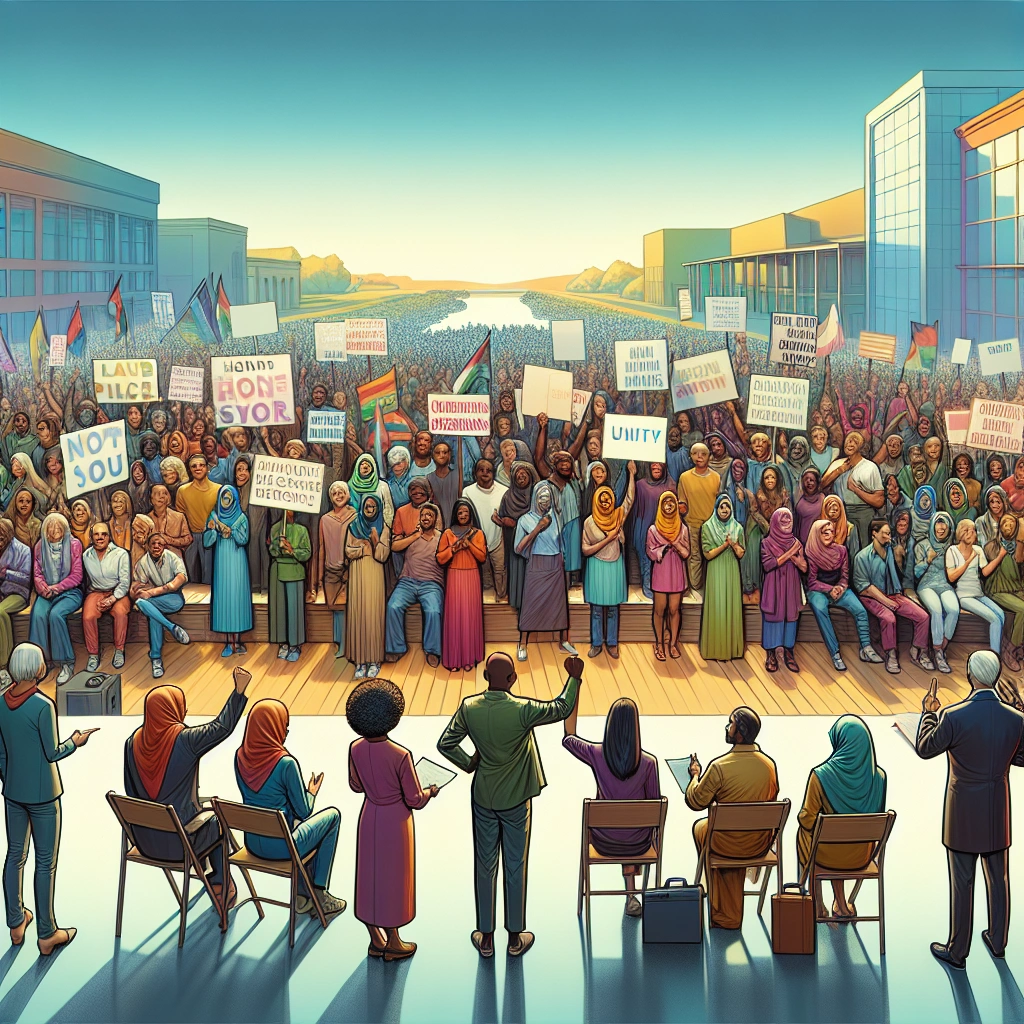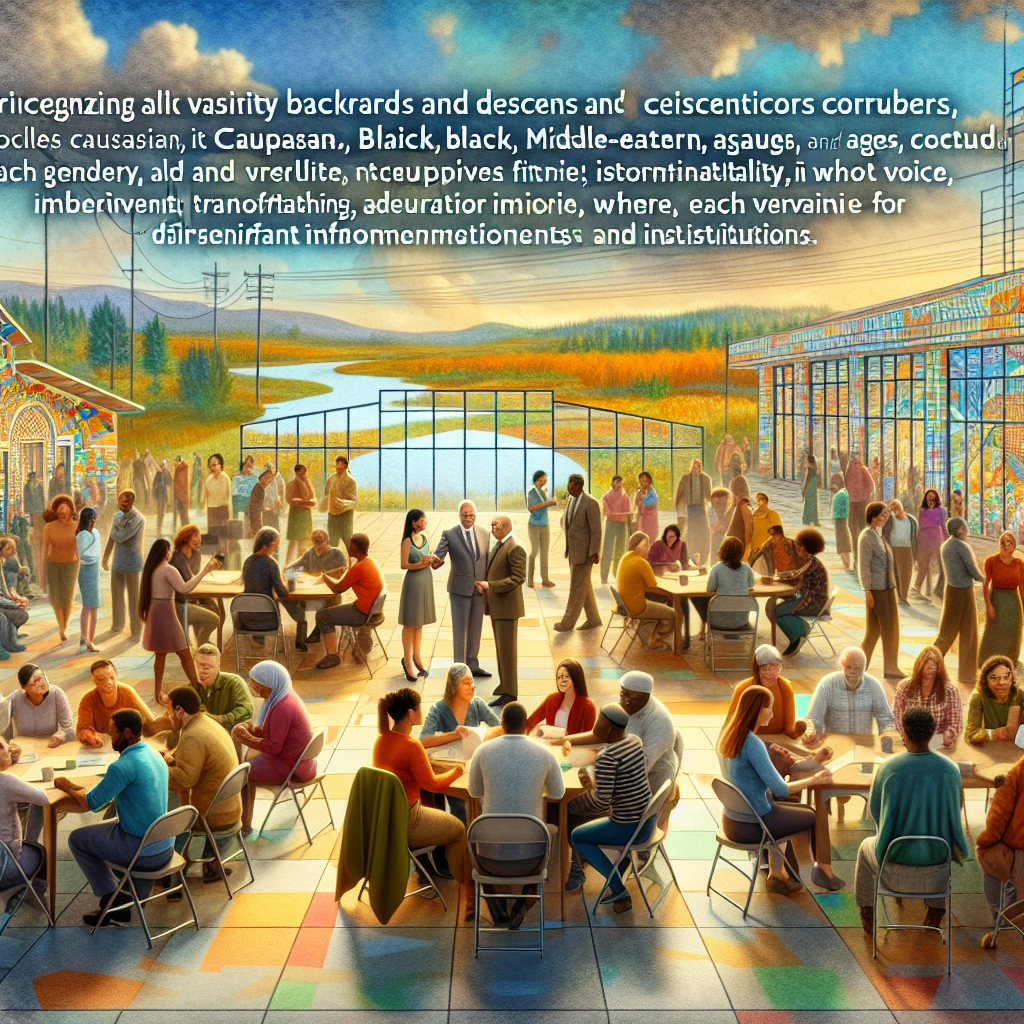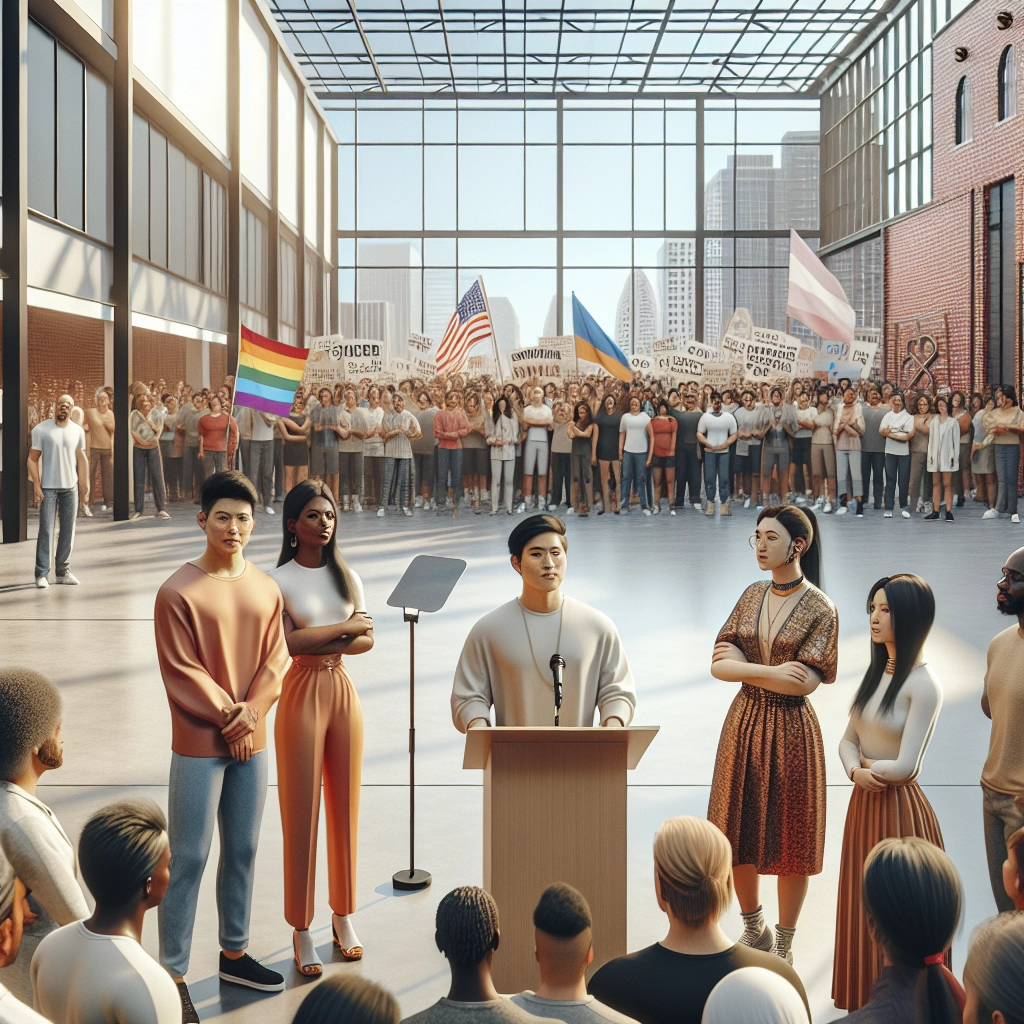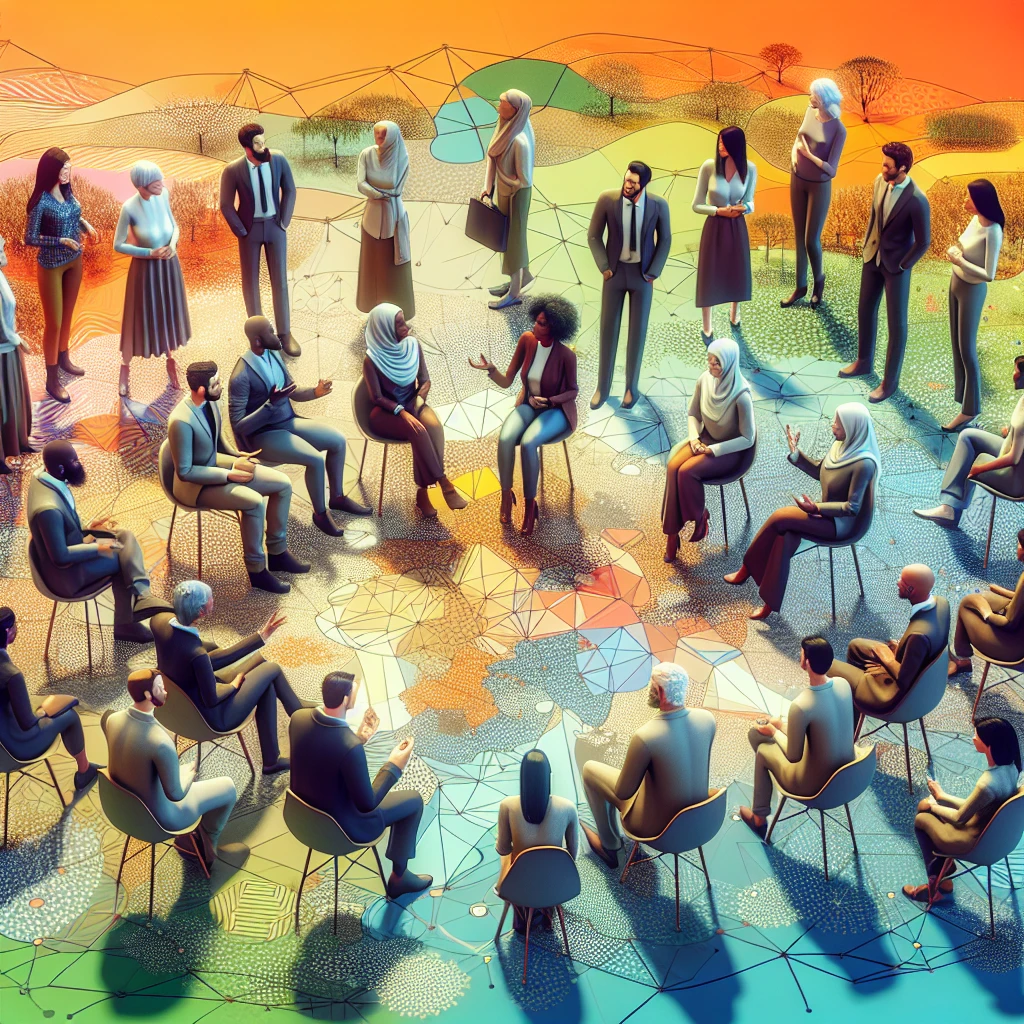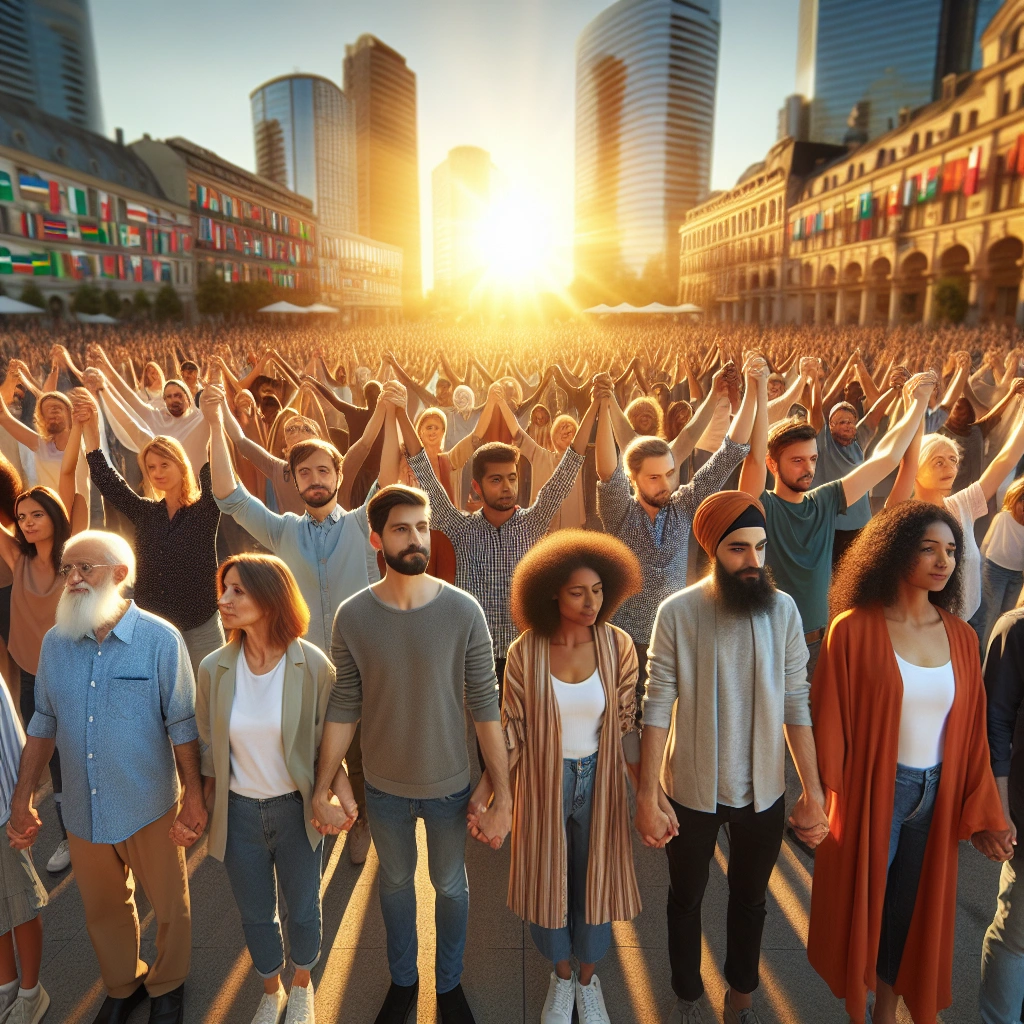What Is Intersectionality And Its Significance In Social Movements And Organizations: A Guide


Intersectionality refers to the interconnected nature of social categorizations such as race, class, and gender as they apply to an individual or group. It is important to understand intersectionality in social movements and organizations because it recognizes the unique experiences of individuals and how they are impacted by multiple forms of discrimination and oppression.
By acknowledging intersectionality, social movements and organizations can work towards creating more inclusive and equitable spaces for everyone.
Check out this Youtube video: Gain a deeper understanding of intersectionality and its crucial role in social movements and organizations by watching Kimberlé Crenshaw’s insightful explanation.
What Is Intersectionality
Defined term
Intersectionality is the understanding of how various social categories such as race, gender, sexual orientation, class, and disability, intersect and overlap to create unique experiences of discrimination and privilege for individuals. It acknowledges that people can face multiple forms of oppression simultaneously, and these intersecting factors must be considered to fully comprehend the impact of discrimination.
Origin and Development of Intersectionality Theory
The theory of intersectionality was first coined by Kimberlé Crenshaw, a prominent American scholar and lawyer, in 1989. She used the term to illustrate how the experiences of African-American women were marginalized within both feminist and anti-racist discourses, emphasizing the interconnected nature of race and gender-based discrimination. Over time, the theory has evolved to encompass a wide range of social identities and power dynamics, contributing to its significance in understanding complex social issues.
Key Concepts and Components
Key components of intersectionality theory involve recognizing that individuals hold multiple identities and that these intersecting identities influence their experiences within societal structures. It emphasizes the interconnected nature of discrimination and privilege, highlighting how these dynamics impact individual lives.
Intersectionality theory is a crucial tool in comprehending the intricate layers of inequality present within social movements and organizations, paving the way for more inclusive and equitable practices.
Understanding Social Movements and Organizations
Definition of social movements and organizations
A social movement refers to a collective effort where individuals, groups, or organizations unite in pursuit of a common goal or to address a specific social issue. Social movements are characterized by sustained and organized actions aimed at bringing about social change or reform.
They often exhibit a long-lasting commitment and involve various forms of collective action.
Importance of inclusivity and diversity in social movements and organizations
Inclusivity and diversity are integral to the effectiveness and impact of social movements and organizations. Embracing diversity fosters an environment where unique perspectives and experiences are valued, leading to a broader range of ideas and solutions.
Inclusive movements have historically demonstrated the power to unite people from diverse backgrounds towards a shared cause, promoting understanding and empathy within society. Similarly, in organizations, diversity brings about increased creativity, better decision-making, and a positive impact on morale and productivity.
| Key Benefits of Inclusivity and Diversity |
|---|
| 1. Enhanced creativity and innovation |
| 2. Improved decision-making |
| 3. Positive impact on morale and productivity |
| 4. Fostering understanding and empathy in society |
| 5. Uniting people from diverse backgrounds towards a common cause |
Significance of Intersectionality in Social Movements
Impact of intersectionality on social movements
The impact of intersectionality on social movements is profound. By recognizing and addressing the intersecting layers of oppression and discrimination faced by individuals, intersectional approaches have amplified the voices of marginalized groups, leading to more inclusive and effective advocacy.
This has empowered movements to fight systemic inequalities with a deeper understanding of the interconnected nature of oppression, thereby challenging power structures and fostering greater solidarity among diverse communities.
Case studies and examples of successful implementation of intersectionality in social movements
One powerful example of successful intersectionality in social movements is the Black Lives Matter (BLM) movement. By acknowledging and addressing the intersection of race, gender, and sexual orientation in their advocacy, BLM has brought attention to the unique challenges faced by black LGBTQ+ individuals, offering a more inclusive platform for marginalized voices.
Additionally, the Women’s March has effectively utilized an intersectional approach by addressing issues faced by women from diverse backgrounds, amplifying the impact of their collective advocacy.
| Successful Implementation of Intersectionality in Social Movements |
|---|
| Black Lives Matter (BLM) |
| Women’s March |
Significance of Intersectionality in Organizations
Intersectionality plays a crucial role in creating inclusive workplace environments by recognizing and addressing the interconnected nature of social categorizations such as race, gender, sexuality, and more. By acknowledging these intersecting identities, organizations can better understand and accommodate the diverse needs of their employees, fostering a sense of belonging and safety.
This, in turn, enhances employee morale, engagement, and productivity, contributing to a more cohesive and collaborative work environment.
Role of intersectionality in creating inclusive workplace environments
The role of intersectionality in creating inclusive workplace environments is to ensure that all employees, regardless of their multiple intersecting identities, feel valued, respected, and included. It involves understanding the unique challenges and experiences of individuals from diverse backgrounds and implementing policies and practices that actively support and promote their inclusion.
Adopting an intersectional approach empowers organizations to mitigate bias, discrimination, and inequality, ultimately leading to a more harmonious and supportive workplace culture.
Benefits of embracing intersectionality in organizations
Embracing intersectionality in organizations yields numerous benefits, including improved diversity and inclusion outcomes, enhanced innovation, and heightened employee satisfaction and retention. By recognizing the complexities of individual identities, organizations can tailor their strategies to better support and nurture their diverse talent pool.
This, in turn, fosters a sense of belonging and empowerment, driving positive business outcomes and reinforcing the organization’s reputation as a leader in diversity and inclusion efforts.
Challenges in Implementing Intersectionality
Implementing intersectionality in social movements and organizations can be challenging due to various barriers. The complexities of addressing multiple systems of oppression based on race, gender, class, and other factors often lead to resistance and lack of understanding.
One barrier is the resistance to change within existing power structures, as implementing intersectionality may require reevaluating traditional approaches and reallocating resources. Additionally, inadequate awareness and education about intersectionality lead to skepticism and reluctance to embrace its significance in creating inclusive spaces.
Overcoming these challenges and creating inclusive spaces involves addressing the discomfort of discussing privilege and power dynamics, fostering open dialogue about intersectionality, and providing ongoing education and training. It also requires actively listening to marginalized voices, centering their experiences, and incorporating diverse perspectives into decision-making processes.
| Challenges | Strategies |
|---|---|
| Resistance to change within power structures | Reevaluate traditional approaches and resource allocation |
| Lack of awareness and education about intersectionality | Foster open dialogue and provide ongoing education and training |
| Discomfort in discussing privilege and power dynamics | Actively listen to marginalized voices and incorporate diverse perspectives into decision-making processes |
By acknowledging these barriers and actively working to overcome them, organizations and social movements can effectively implement intersectionality and create more equitable and inclusive environments.
Intersectionality and Gender
Intersectionality’s impact on gender issues in social movements
Intersectionality’s impact on gender issues in social movements is significant as it emphasizes the interconnected nature of social categorizations such as race, class, and gender. This approach acknowledges that individuals can experience multiple forms of discrimination simultaneously, leading to a more comprehensive understanding of gender inequality within social movements.
For example, in the fight for gender equality, an intersectional approach recognizes that women of color may face unique challenges that differ from those faced by their white counterparts, necessitating tailored and inclusive strategies for advocacy and empowerment.
Achieving gender equality through an intersectional approach
Achieving gender equality through an intersectional approach involves recognizing the diverse and overlapping experiences of individuals within social movements. By acknowledging and addressing the intersections of race, class, and gender, organizations can create more inclusive and effective initiatives for gender equality.
For instance, implementing policies and programs that consider the unique challenges faced by LGBTQ+ women of color in the workplace is essential for fostering genuine gender equality.
Intersectionality and Race
Intersectionality’s role in addressing racial discrimination is crucial in recognizing the multifaceted nature of discrimination. By acknowledging that individuals experience multiple and intersecting forms of oppression, intersectionality helps to address the complexities of racial discrimination.
It allows for a deeper understanding of how race intersects with other identity markers, such as gender, class, and sexuality, creating unique experiences of discrimination for different individuals.
Historical context and modern-day examples of intersectionality and race in social movements and organizations underscore the significance of recognizing the interconnectedness of various forms of discrimination. For instance, the civil rights movement of the 1960s exemplifies the intersectionality of race and gender, as women of color played pivotal roles while facing dual discrimination.
In contemporary times, movements like Black Lives Matter highlight intersectionality by addressing not only racial injustice but also how it intertwines with issues of gender identity, class, and systemic inequality.
| Historical Context and Modern-Day Examples of Intersectionality and Race |
|---|
| * Civil Rights Movement |
| – Women of Color’s Role |
| * Black Lives Matter Movement |
| – Intersectionality and Gender Identity |
| – Addressing Systemic Inequality |
Intersectionality and LGBTQ+ Rights
Intersectionality’s impact on LGBTQ+ rights movements
Intersectionality has played a crucial role in advancing LGBTQ+ rights movements by highlighting the interconnected nature of social categorizations such as race, gender, and sexual orientation. Through an intersectional lens, the LGBTQ+ community acknowledges and addresses the unique challenges faced by individuals who belong to multiple marginalized groups.
Challenges faced and progress made through an intersectional approach
Challenges faced by the LGBTQ+ community include discrimination in personal lives, employment, housing, and access to healthcare, particularly affecting transgender persons and individuals of color. Despite these challenges, progress has been made through intersectional approaches, such as the legalization of same-sex marriage and protection from workplace discrimination under the Civil Rights Act.
| Challenges Faced | Progress Made |
|---|---|
| Discrimination in personal lives, employment, housing, and healthcare | Legalization of same-sex marriage and protection from workplace discrimination |
Intersectionality has been a vital tool in advancing LGBTQ+ rights, enabling a foundational framework for understanding and addressing the diverse realities of LGBTQ+ people. Embracing an intersectional approach is essential to continuing the progress towards equality and inclusion for the LGBTQ+ community.
Intersectionality and Disability Advocacy
Role of intersectionality in advocating for disability rights
Intersectionality plays a crucial role in advocating for disability rights by recognizing the unique experiences of individuals who have multiple marginalized identities. It highlights the intersection of factors such as race, gender, age, and disability, shedding light on the complex challenges faced by those with disabilities from diverse backgrounds.
This approach enables the development of policies and interventions that are more inclusive and equitable, addressing the specific needs of various communities within the disabled population.
Promoting accessibility and inclusivity within organizations through an intersectional lens
Promoting accessibility and inclusivity within organizations through an intersectional lens involves recognizing the deep-rooted systemic issues that perpetuate exclusivity within the disability sector, particularly for individuals with intersecting marginalized identities. By adopting an intersectional approach, organizations can develop comprehensive strategies that address all barriers, embed inclusion in talent processes, and create policies and practices that consider the diverse experiences of individuals with disabilities from different backgrounds.
This fosters a more inclusive and equitable workplace environment, allowing for the full participation of all employees, regardless of their intersecting identities.
The Role of Leadership in Embracing Intersectionality
Importance of leadership in promoting intersectionality
Leadership plays a crucial role in promoting intersectionality by setting the tone for inclusivity and diversity within an organization.
When leaders prioritize and actively promote intersectionality, they pave the way for creating a culture where individuals from all walks of life feel valued, heard, and empowered. By embracing intersectionality, leaders showcase their commitment to understanding and addressing the unique challenges faced by individuals with diverse backgrounds and experiences.
Strategies for fostering inclusive leadership in social movements and organizations
To foster inclusive leadership, organizations can implement strategies such as mentoring programs that pair individuals from different backgrounds, providing diversity and inclusion training for leaders, and creating affinity groups to empower employees with shared experiences.
Additionally, establishing clear diversity goals, measuring progress, and holding leaders accountable for creating an inclusive environment are essential strategies for fostering inclusive leadership in social movements and organizations.
| Strategies for Inclusive Leadership |
|---|
| Implement mentoring programs |
| Provide diversity and inclusion training |
| Create affinity groups |
| Set clear diversity goals |
| Measure progress |
| Hold leaders accountable |
By implementing these strategies, organizations can cultivate a culture of inclusive leadership that embraces intersectionality and empowers all individuals to thrive.
Measuring the Impact of Intersectionality
Tools and metrics for assessing the impact of intersectionality
The tools and metrics for assessing the impact of intersectionality include quantitative research methods such as chi-square analysis and multiple regression. These methods allow for the evaluation of how interlocking systems of power and oppression influence the lived experiences of historically marginalized groups.
Additionally, the Intersectionality Resource Guide and Toolkit by UN Women provides a comprehensive resource for assessing knowledge, attitudes, and practices at both individual and program levels. Furthermore, the integration of theoretical frameworks and innovative methods in health research serves as a crucial aspect of evaluating the impact of intersectionality.
Case studies illustrating the positive effects of intersectionality on social movements and organizations
One prominent case study demonstrating the positive effects of intersectionality is the amplification of the need for addressing inequalities during the COVID-19 crisis. It has shown that those experiencing intersectional discrimination face disproportionate impacts in terms of access to healthcare, risk of violence, unemployment, and well-being.
Another significant example is the application of intersectionality as a social movement strategy to address health inequities, reduce disparities, and promote social justice. Additionally, the complexities of multiple resistant knowledge projects inform intersectionality, emphasizing the importance of addressing the parallel and intertwining narratives of marginalized groups.
| Tools and Metrics | Case Studies |
|---|---|
| Quantitative research methods (e.g., chi-square analysis, multiple regression) | Amplified need for addressing inequalities during the COVID-19 crisis |
| Intersectionality Resource Guide and Toolkit by UN Women | Application of intersectionality as a social movement strategy |
| Integration of theoretical frameworks and innovative methods in health research | Complexities of multiple resistant knowledge projects |
The use of quantitative methods and theoretical frameworks in assessing intersectionality highlights the significance of implementing effective tools and metrics. Similarly, the positive impact observed in case studies emphasizes the need for addressing inequalities and promoting social justice through intersectionality.
Cultivating Intersectional Allies and Advocates
Strategies for recruiting and supporting intersectional allies
To recruit and support intersectional allies effectively, organizations must create diverse job postings that emphasize inclusivity and equality. Leveraging diverse recruitment sources, such as community organizations and platforms tailored to underrepresented groups, can significantly broaden the talent pool.
Additionally, utilizing inclusive interview panels representing diverse backgrounds ensures a fair evaluation process, while providing training on recognizing and addressing implicit biases can help support intersectional allyship within the organization.
Promoting advocacy and allyship within social movements and organizations
Promoting advocacy and allyship within social movements and organizations involves reviewing current policies, practices, and procedures through an Equity, Diversity, and Inclusion (EDI) and intersectional lens. Identifying gaps and areas for improvement while fostering a culture of empathy and understanding can encourage active allyship.
Establishing anti-racism through corporate policies, including initiatives such as diverse mentorship programs and companywide policies that support underrepresented groups, is crucial in promoting advocacy and allyship within organizations and broader social movements.
Building Intersectional Coalitions
Importance of forming intersectional coalitions
Forming intersectional coalitions is crucial in social movements and organizations as it allows for the inclusion of diverse experiences and perspectives. By bringing together individuals from various identity categories, such as race, gender, and sexual orientation, these coalitions can address a wider range of societal issues, leading to more holistic and impactful solutions.
Moreover, these collaborations foster understanding and empathy, breaking down barriers and creating a sense of unity among different groups.
One example of the significance of forming intersectional coalitions can be seen in the LGBTQ+ rights movement, where alliances between people of different sexual orientations, gender identities, and cultural backgrounds have played a pivotal role in advocating for equal rights and societal acceptance. This diversity within the coalition has allowed for a more comprehensive approach to addressing the challenges faced by the LGBTQ+ community, leading to tangible progress in policy reforms and public perception.
Case studies demonstrating the power of intersectional collaboration in achieving social change
A notable case study showcasing the power of intersectional collaboration is the #MeToo movement, which brought together individuals from various backgrounds to address issues of sexual harassment and assault. By uniting people of different races, genders, and socio-economic statuses, the movement amplified the voices of those who had been marginalized and overlooked, leading to a global conversation about consent, boundaries, and workplace ethics.
Another compelling example of intersectional collaboration driving social change is the civil rights movement in the United States during the mid-20th century. Through the coalition formed by leaders from diverse racial and ethnic groups, the movement was able to push for legislative changes, challenge systemic discrimination, and ultimately pave the way for greater equality and justice.
| Intersectional Coalitions | Impact |
|---|---|
| LGBTQ+ rights movement | Equal rights advocacy and societal acceptance |
| #MeToo movement | Global conversation about consent and workplace ethics |
| Civil rights movement | Legislative changes and greater equality |
In essence, forming intersectional coalitions is not just beneficial but necessary for addressing complex societal issues. These coalitions bring together a rich tapestry of voices, experiences, and expertise, enabling them to tackle challenges with a level of depth and understanding that can truly drive meaningful social change.
Educating and Empowering Through Intersectionality
Role of education in promoting intersectional understanding
Education plays a crucial role in promoting intersectional understanding by incorporating diverse perspectives into the curriculum. For example, history lessons can highlight the contributions of individuals from different races and genders, fostering empathy and breaking down stereotypes.
Additionally, encouraging open discussions about identity and privilege in the classroom can help students develop a deeper appreciation for intersectionality.
Empowering individuals to advocate for intersectionality in their communities and workplaces
Empowering individuals to advocate for intersectionality involves providing them with the knowledge and tools to recognize and address systemic inequalities. Workshops and training programs can equip employees with the skills to create inclusive environments and challenge discriminatory practices.
By amplifying diverse voices and promoting allyship, organizations can foster a culture of intersectional advocacy and empower individuals to drive meaningful change.
Addressing Counterarguments Against Intersectionality
Intersectionality, often misunderstood, faces common misconceptions and objections. Critics sometimes view it as a competition for the most marginalized status, but in reality, it seeks to acknowledge the diverse layers of oppression individuals may face.
Debunking these myths is crucial to understanding its significance in social movements and organizations. By addressing opposition with accurate information, we can pave the way for a more inclusive and empathetic society.
Recommended Amazon Products for Understanding Intersectionality in Social Movements and Organizations
Here’s a curated list of products that can help you learn more about understanding intersectionality in social movements and organizations. These recommendations are based on their relevance to the topic and positive customer reviews.
Book: “Intersectionality” by Patricia Hill Collins


This book provides an in-depth explanation of intersectionality and its significance in social movements and organizations. It is highly recommended for its comprehensive coverage of the topic.
Documentary: “13th” Directed by Ava DuVernay


The documentary “13th” explores the intersectionality of race and the criminal justice system. It offers valuable insights into social movements and the impact of intersectionality on marginalized communities.
Training Manual: “Inclusive Leadership Training Guide”


This training manual offers practical guidance on promoting inclusivity and diversity in organizations. It provides actionable strategies for embracing intersectionality in leadership.
Educational Game: “Diversity and Inclusion Board Game”


This board game is designed to educate players about intersectionality, diversity, and inclusion. It can be used as a learning tool in both social movements and organizational settings.
Workplace Poster: “Celebrating Diversity and Inclusivity”


This poster serves as a visual reminder of the importance of intersectionality in creating inclusive workplace environments. It offers a tangible way to promote awareness and understanding.
Top Recommended Product for Understanding Intersectionality in Social Movements and Organizations
If you’re looking for the best solution for understanding intersectionality in social movements and organizations, we highly recommend the book “Intersectionality” by Patricia Hill Collins. Here’s why:
| Pros | Cons |
|---|---|
| Comprehensive coverage of the topic | Availability of digital format |
| Well-researched and insightful | Limited availability in some areas |
| Positive reviews from readers |
Ready to dive into the world of intersectionality? Check out Intersectionality by Patricia Hill Collins today for a valuable resource!


Make sure all the listed products have an anchor Amazon search link. Also, the top recommended product should have an anchor Amazon search link.
Conclusion
Intersectionality plays a crucial role in driving social change and fostering inclusive environments in organizations by acknowledging the interconnected nature of various forms of oppression and discrimination. This understanding allows for more comprehensive and effective strategies to address the complex challenges faced by individuals and groups within society.
Furthermore, the significance of intersectionality in social movements and organizations lies in its ability to promote equity and justice for all, regardless of their race, gender, sexual orientation, ability, or other identities. By recognizing the intersectional experiences of individuals, organizations can create policies and practices that are more inclusive and representative of diverse perspectives, ultimately leading to a more just and equitable society.
Intersectionality serves as a framework for understanding and addressing the overlapping systems of oppression and inequality that impact individuals and communities. This nuanced approach ensures that efforts to drive social change and foster inclusive environments in organizations are more holistic and effective, as they account for the multiple layers of discrimination and marginalization that individuals may face.



